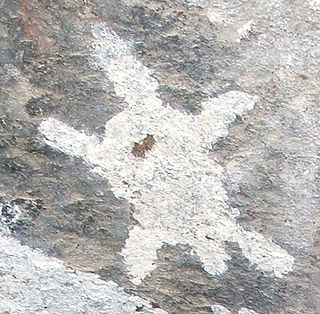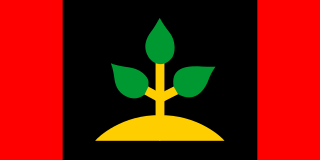
Barwon River, a perennial river that is part of the Murray–Darling basin, is located in the north-west slopes and Orana regions of New South Wales, Australia.

The Ngunnawal people, also spelt Ngunawal, are an Aboriginal people of southern New South Wales and the Australian Capital Territory in Australia.
The Ngiyambaa language, also spelt Ngiyampaa, Ngempa, Ngemba and other variants, is a Pama–Nyungan language of the Wiradhuric subgroup. It was the traditional language of the Wangaibon and Weilwan peoples of New South Wales, Australia, but is now moribund; according to Donaldson by the 1970s there were only about ten people fluent in Wangaibon, whilst there were only a couple of Weilwan speakers left.

The Larrakia people are a group of Aboriginal Australian people in and around Darwin in the Northern Territory. The Larrakia, who refer to themselves as "Saltwater People", had a vibrant traditional society based on a close relationship with the sea and trade with neighbouring groups such as the Tiwi, Wadjiginy and Djerimanga. These groups shared ceremonies and songlines, and intermarried.
The Wardaman people are a small group of Aboriginal Australians living about 145 kilometres (90 mi) South-West of Katherine, on Menngen Aboriginal Land Trust in the Northern Territory of Australia.
The Turrbal are an Aboriginal Australian people from the region of Brisbane, Queensland. The name primarily refers to the dialect they speak, the tribe itself being alternatively called Mianjin/Meanjin. Mianjin is also the Turrbal word for the central Brisbane area. The traditional homelands of the Turrbal stretch from the North Pine River, south to the Logan River, and inland as far as Moggill, a range which includes the city of Brisbane.
Wanggamala, also spelt Wanggamanha, Wangkamahdla, Wangkamadla, Wangkamanha, Wangkamana, Wonkamala, Wongkamala, Wonkamudla, and other variants, is an extinct Australian Aboriginal language of the Pama–Nyungan family, previously spoken in the Northern Territory around Hay River and to the south of the Andegerebinha-speaking area.
The Wangaaypuwan, also known as the Wangaibon or Ngiyampaa Wangaaypuwan, are an Aboriginal Australian people who traditionally lived between Nyngan, the headwaters of Bogan Creek, and on Tigers Camp and Boggy Cowal creeks and west to Ivanhoe, New South Wales. They are a clan of the Ngiyampaa nation.
The Umpila people are an Aboriginal Australian people of the eastern Cape York Peninsula in northern Queensland. The majority of the remnant of the Umpila now live in Lockhart.
The Kokangol (Koko-Gol), or Yuwula, are said to have been an Indigenous Australian people of Queensland. Some dispute this, suggesting the name may be a synonym for Aghu Tharnggala, or may simply be the name of a language consultant.
The Barindji, also written Parrintyi, are an indigenous Australian people of the state of New South Wales. They are to be distinguished from the Paaruntyi, who spoke a similar language but whom they called the spitting people.
The Kurung were identified as an indigenous Australian group of the State of Victoria by Norman Tindale. The theory that they constituted an independent tribe has been challenged with modern scholarship generally considering them a clan, associated to one of two major tribes. Their language is unconfirmed.
The Koamu (Guwamu) were an indigenous Australian people of the state of Queensland.
The Maia were an indigenous Australian tribe of Western Australia.
The Ngiyampaa, also known as the Ngemba, are an Aboriginal Australian people of the state of New South Wales. The generic name refers to an aggregation of three groups, the Ngiyampaa, the Ngiyampaa Wangaaypuwan, and the Ngiyampaa Weilwan, respectively clans of a larger Ngiyampaa nation.
The Barranbinya, also written Baranbinja and other variants, are an Aboriginal Australian people of New South Wales.
The Wilawila are an indigenous Australian tribe of the Kimberley region of Western Australia.
The Wakaman(Tindale) otherwise spelt Wagaman are an Indigenous Australian people of the state of Queensland. According to some authorities, they may be interchangeable with the group identified by ethnographers as the Ewamin.
The Yalarnnga, also known as the Jalanga, are an Indigenous Australian people of the state of Queensland.
The Kokomini (Gugumini) are reported to have been an indigenous Australian people of the state of Queensland, though some indications suggest the term may refer to a loose confederation of tribal groups.